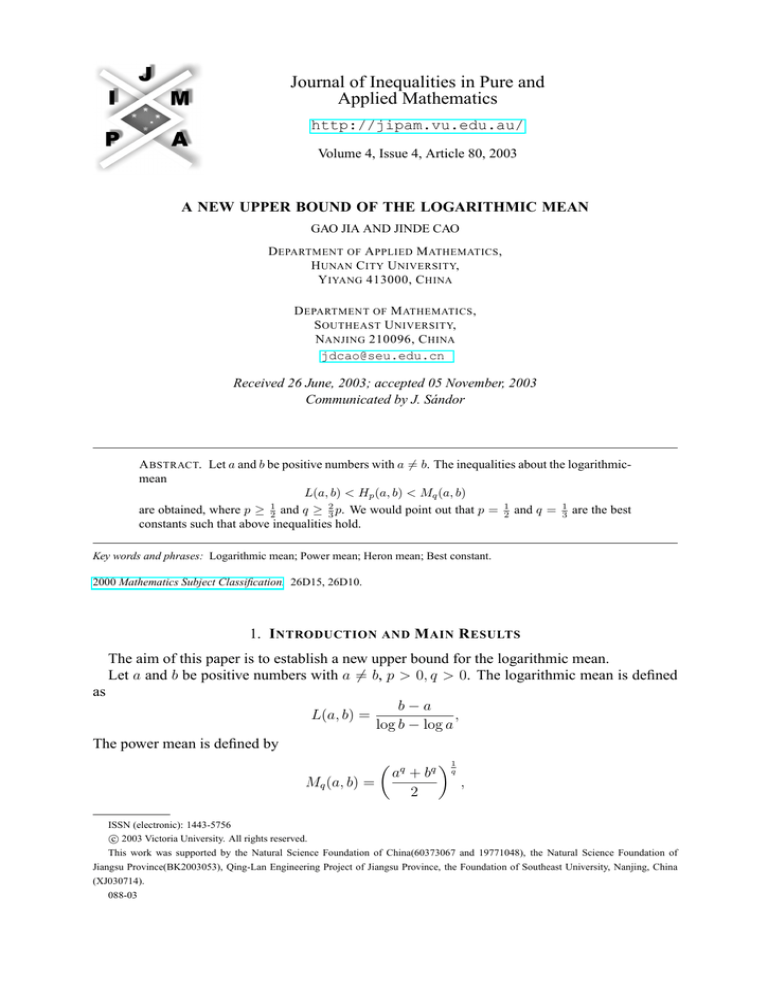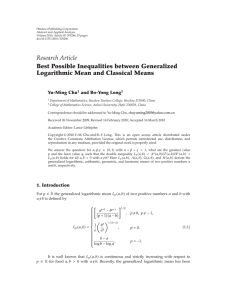
Journal of Inequalities in Pure and
Applied Mathematics
http://jipam.vu.edu.au/
Volume 4, Issue 4, Article 80, 2003
A NEW UPPER BOUND OF THE LOGARITHMIC MEAN
GAO JIA AND JINDE CAO
D EPARTMENT OF A PPLIED M ATHEMATICS ,
H UNAN C ITY U NIVERSITY,
Y IYANG 413000, C HINA
D EPARTMENT OF M ATHEMATICS ,
S OUTHEAST U NIVERSITY,
NANJING 210096, C HINA
jdcao@seu.edu.cn
Received 26 June, 2003; accepted 05 November, 2003
Communicated by J. Sándor
A BSTRACT. Let a and b be positive numbers with a 6= b. The inequalities about the logarithmicmean
L(a, b) < Hp (a, b) < Mq (a, b)
are obtained, where p ≥ 12 and q ≥ 23 p. We would point out that p = 12 and q = 13 are the best
constants such that above inequalities hold.
Key words and phrases: Logarithmic mean; Power mean; Heron mean; Best constant.
2000 Mathematics Subject Classification. 26D15, 26D10.
1. I NTRODUCTION AND M AIN R ESULTS
The aim of this paper is to establish a new upper bound for the logarithmic mean.
Let a and b be positive numbers with a 6= b, p > 0, q > 0. The logarithmic mean is defined
as
L(a, b) =
b−a
,
log b − log a
The power mean is defined by
Mq (a, b) =
aq + b q
2
1q
,
ISSN (electronic): 1443-5756
c 2003 Victoria University. All rights reserved.
This work was supported by the Natural Science Foundation of China(60373067 and 19771048), the Natural Science Foundation of
Jiangsu Province(BK2003053), Qing-Lan Engineering Project of Jiangsu Province, the Foundation of Southeast University, Nanjing, China
(XJ030714).
088-03
2
G AO J IA AND J INDE C AO
and the Heron mean is defined as
Hp (a, b) =
ap + (ab)p/2 + bp
3
p1
.
There are many important results concerning L(a, b), Mp (a, b) and Hq (a, b). The well known
Lin Tong-Po inequality (see [1]) is stated as
L(a, b) < M 1 (a, b).
(1.1)
3
In [2], Yang Z.H. obtained the inequalities
L(a, b) < M 1 (a, b) < H1 (a, b).
(1.2)
2
In [1], Kuang J. C. summarized and stated the interpolation inequalities
L(a, b) < M 1 (a, b) < M 1 (a, b) < H1 (a, b) < M 2 (a, b).
(1.3)
3
2
3
In this paper, we further improve the upper bound of the logarithmic mean and obtain the
following theorem:
Theorem 1.1. Let p ≥ 12 , q ≥ 23 p, and a, b be positive numbers with a 6= b. We then have
L(a, b) < Hp (a, b) < Mq (a, b).
(1.4)
Furthermore, p = 12 , q =
2
3
are the best constants for (1.4).
2. P ROOF OF T HEOREM 1.1
In this section, there are two goals: the first is to state and prove some fundamental lemmas.
The second is to prove our main result by virtue of these lemmas.
Lemma 2.1. ([3], [4]). Suppose a and b are fixed positive numbers with a 6= b. For p > 0, then
Hp (a, b) and Mp (a, b) are strictly monotone increasing functions with respect to p.
Lemma 2.2. Let x > 1. Then
x−1
<
log x
(2.1)
1
1
x2 + x4 + 1
3
!2
.
1
Proof. Taking t = x 4 , where x > 1, it is easy to see that inequality (2.1) is equivalent to
t4 − 1
1
< (t2 + t + 1)2 .
4 log t
9
(2.2)
Define the function
f (t) =
(2.3)
4
t4 − 1
log t − 2
.
9
(t + t + 1)2
Calculating the derivative for f (t), we get
4
4t3 (t2 + t + 1) − 2(t4 − 1)(2t + 1)
−
9t
(t2 + t + 1)3
2(t − 1)4 (2t2 + 5t + 2)
=
.
9t(t2 + t + 1)3
f 0 (t) =
1
Since t = x 4 > 1, we find that f 0 (t) > 0. Obviously, f 0 (1) = 0. So f (t) > 0 for t > 1. i.e.
(2.1) holds.
J. Inequal. Pure and Appl. Math., 4(4) Art. 80, 2003
http://jipam.vu.edu.au/
A N EW U PPER B OUND OF THE L OGARITHMIC M EAN
3
Lemma 2.3. Let x > 1, then the following inequality holds
!2
!3
1
1
1
x2 + x4 + 1
x3 + 1
(2.4)
<
.
3
2
1
Proof. Taking t = x 12 , where x > 1, it is easy to see that inequality (2.4) is equivalent to
9(t4 + 1)3 > 8(t6 + t3 + 1)2 .
(2.5)
Define a function g(t) as
g(t) = 9(t4 + 1)3 − 8(t6 + t3 + 1)2 .
Factorizing g(t), we obtain
g(t) = (t − 1)4 (1 + 4t + 10t2 + 4t3 − 2t4 + 4t5 + 10t6 + 4t7 + t8 )
= (t − 1)4 ((t4 − 1)2 + 4t + 10t2 + 4t3 + 4t5 + 10t6 + 4t7 ).
The proof is completed.
Proof of Theorem 1.1. We first prove, for p = 21 , q = 13 , that (1.4) is true. In fact, since a >
0, b > 0 and a 6= b, there is no harm in supposing b > a. If we take x = ab , using Lemma 2.2
and Lemma 2.3, we have
L(a, b) < H 1 (a, b) < M 1 (a, b).
(2.6)
For q ≥
2
2
p,
3
3
there is the known result ([1])
Hp (a, b) < Mq (a, b), (a 6= b).
(2.7)
Using Lemma 2.1, combining (2.6) and (2.7), we can conclude that
1
2
L(a, b) < H 1 (a, b) < Hp (a, b) < Mq (a, b), p ≥ , q ≥ p .
2
2
3
Next, we prove that p =
following inequalities
(2.8)
1
2
and q =
1
3
are the best constants for (1.4). Suppose we know that the
L(x, 1) < Hp (x, 1) < Mq (x, 1),
hold for any x > 1. There is no harm in supposing 1 < x ≤ 2. (In fact, if n < x ≤ n + 1, we
can take t = x − n, where n is a positive integer.) Taking t = x − 1, applying Taylor’s Theorem
to the functions L(x, 1), Hp (x, 1) and Mq (x, 1), we have
1
1
(2.9)
L(x, 1) = L(t + 1, 1) = 1 + t − t2 + · · · ,
2
12
(2.10)
1
2p − 3 2
Hp (x, 1) = Hp (t + 1, 1) = 1 + t +
t + ··· ,
2
24
1
q−1 2
Mq (x, 1) = Mq (t + 1, 1) = 1 + t +
t + ··· ,
2
8
With simple manipulations (2.9), (2.10) and (2.11), together with (2.8), yield
1
2p − 3
q−1
(2.12)
− ≤
≤
.
12
24
8
From (2.12), it immediately follows that
1
2
p ≥ , and q ≥ p.
2
3
(2.11)
J. Inequal. Pure and Appl. Math., 4(4) Art. 80, 2003
http://jipam.vu.edu.au/
4
G AO J IA AND J INDE C AO
We then have, by virtue of Lemma 2.1, that p =
1
2
and q =
1
3
are the best constants for (1.4).
Remark
2.4. It is easy to see that the best lower bound of the logarithmic mean is H0 (a, b) =
√
ab, namely H0 = G, the geometric mean. In addition, using Lemma 2.1, combining (1.4),
(2.7), (2.8) and the related results in [1], we derive the following graceful inequalities
√
ab < L(a, b) < H 1 (a, b) < M 1 (a, b) < Mα (a, b) < Hβ (a, b) < Mγ (a, b),
2
where
1
3
<α<
log 2
β,
log 3
γ≥
2
β,
3
3
β>
log 3
.
3 log 2
ACKNOWLEDGMENT
The authors would like to thank the referees for their valuable suggestions.
R EFERENCES
[1] J.C. KUANG, Applied Inequalities, Hunan Eduation Press, 2nd. Ed., 1993.
[2] Z.H. YANG, The exponent means and the logarithmic means, Mathematics in Practice and Theory,
4 (1987), 76–78.
[3] B.F. BECKENBACH AND R. BELLMAN, Inequalities, Spring-Verlag, 1961.
[4] G.H. HARDY, J.E. LITTLEWOOD AND G. PÓLYA, Inequalities, Cambridge, 2nd Ed., 1952.
J. Inequal. Pure and Appl. Math., 4(4) Art. 80, 2003
http://jipam.vu.edu.au/












